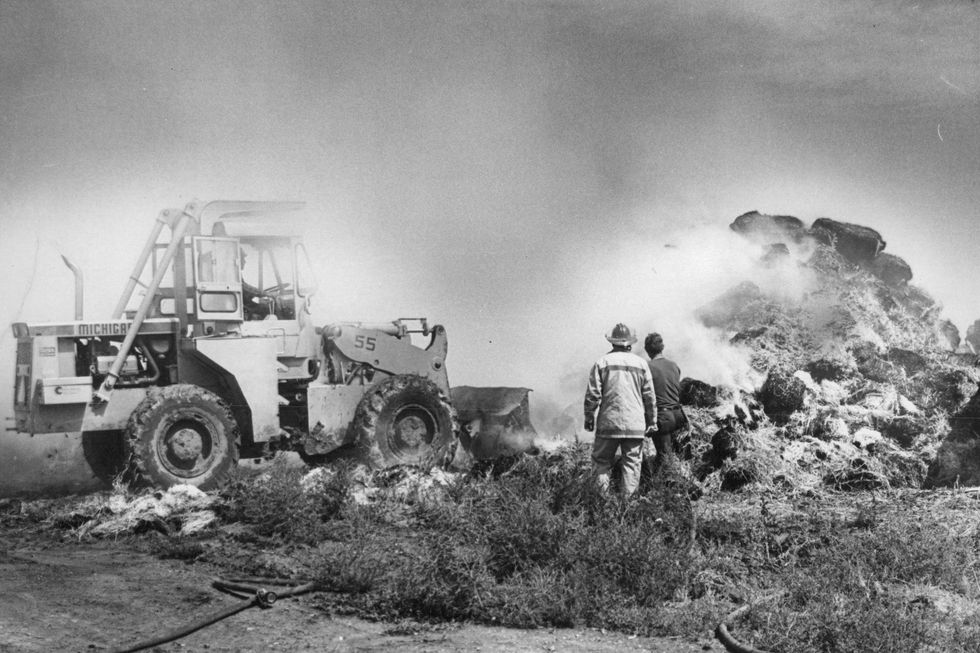- Spontaneous combustion is a chemical reaction, plain and simple.
- The core reaction is oxidation, when materials degrade while exposed to oxygen.
- The reaction releases heat, and sometimes that heat is trapped until it can ignite.
Last month, a barn near rural Jackson, Michigan, caught fire in a suspected spontaneous combustion. The culprit is wet hay, which is counterintuitive if you don’t know much about the underlying science; turns out, there are many ways for materials like hay to spontaneously combust. That set our curiosity ablaze: what is combustion, anyway? How is it different from ignition, which can also be spontaneous? And what about . . . human spontaneous combustion?
First, a quick note on terminology. In the vernacular sense, we use the word “spontaneous” to mean “sudden” or “spur of the moment.” That’s close to—but not exactly—what scientists mean when they call things spontaneous.
“‘Spontaneous’ is used to describe events or conditions that arise without the action of an external influence,” Tom Cleary, a chemical engineer in the Fire Research Division at the National Institute of Standards and Technology, tells Popular Mechanics. “Spontaneous combustion requires no external ignition source, spontaneous gene mutation has no identified external cause, and spontaneous fission, as in radioactive decay of an atom, takes place randomly with no external stimulus.”
Cleary mentions an external ignition source, and that brings up an important distinction: what makes combustion different from ignition? “[Ignition] is an energy source like a spark, flame or other high-temperature object or event that provides the initial local energy to start combustion of a fuel source,” he explains.
⚠️ Check your paper towels, because some mixed-composure ones can catch fire in the microwave due to microscopic metal content.
That idea of initial local energy is important. If you put a piece of regular paper in your oven at a high enough temperature, it will catch fire on its own without anyone lighting a match. If you do strike a match, the temperature can reach 1,500 degrees Fahrenheit, but we know from Ray Bradbury that paper burns at just 451 degrees—the temperature at which many people are roasting vegetables or crisping up tater tots.
So your oven is applying initial local energy when a piece of paper catches fire. That’s a clear external cause. But what if the initial local energy comes from a chemical reaction within a substance itself? This is where we come back to hay, which may be the most iconic example of spontaneous combustion.
Hay and Feed
Hay is not a plant, but rather a feed product from one of many varieties of grassy plant that can be dried and then fed to livestock. The drying step is very important: You need to dry a plant if you want to keep it for a longer amount of time. (Think about a bunch of basil in your fridge versus a jar of dried basil that could last a year or longer.) If you bundle a wet plant, it can grow moldy and cause harm to animals.
But there’s one last reason to “make hay while the sun shines”: damp hay can spontaneously combust. Regular damp plants, when not parceled together tightly and kept in certain conditions, will never accumulate enough heat to combust. But packed, moist hay will foster microorganisms that start to break down the hay, and that action releases heat. Without air circulation, the heat stays in the hay and continues to grow. It’s a self-reinforcing cycle that can cascade until some part of the hay reaches the temperature required to ignite.
It’s not just strands of grassy hay that can spontaneously combust, as a 1949 article in Farmers’ Weekly Review explains: “Soybean meal and other bagged feeds that are usually warm at the time of bagging and shipping from the processing plant can easily cause spontaneous combustion if stacked while in this heated condition.” The article conservatively recommends keeping moisture below 12.5 percent, but most experts now suggest keeping it under 20 percent for safety.
Coal
Coal is another archetypal example of spontaneous combustion. In a 1917 safety pamphlet, the Iowa Agricultural Experiment Station explains that coal has even more latent combustibility than hay. But there’s one key difference: coal will never ferment the way moist hay cuttings do. That means the ongoing chemical reaction never boost ambient local energy. So what does it take for coal to spontaneously combust?
The conditions must be just right, combining large and small pieces of coal that are packed tightly together and, usually, interspersed with dusty particulate. In industrial settings or power plants where a massive amount of coal is used, they might have enormous piles of coal that can limit air circulation and lead to accumulation of heat from oxidation—a natural reaction that affects all coal. It is slower and more finicky than hay, but it can still happen.
Drying Oils
There’s one more major category of spontaneous combustion: the drying oils. We use these as binders in materials like paint or as surfacing for wood furniture, and they can’t just stay sticky and greasy forever. The Mona Lisa isn’t attracting every piece of lint floating around in the museum for the last 500 years. And beside oil paint, the use of these oils in finishes like varnish has mostly gone the way of the dodo with the advent of newer binding materials.
So how do drying oils combust? Well, most people know that oily rags are a fire hazard, but at least I always thought this was because they would easily catch fire if exposed to a flame. But it’s not just that. When drying oils are distributed all over the surface area of the woven threads of a rag, and then exposed to air on all those surfaces, they can rapidly oxidize. That chemical reaction is what releases heat as the oxygen basically tears apart the molecular surface of the oil. This is the fastest of the three examples of spontaneous combustion we’ve looked at, and it doesn’t require packed industrial conditions or moisture. Just rags, oil, and air.
Pyrophorics
There’s a technical category of spontaneous combustion that we haven’t mentioned yet. See if you can spot it in this laboratory safety manual passage from 1995: “Examples of materials susceptible to spontaneous combustion include oily rags, dust accumulations, organic materials mixed with strong oxidizing agents, alkali metals (e.g., sodium and potassium), finely divided pyrophoric metals, and phosphorus.”
Did You Know? The word “pyrophoric” is from the Greek for “holds or carries fire.”
There are elements that will catch fire upon any exposure to room temperature air or even to water vapor. Phosphorus might have tipped you off, because white phosphorus is one of the most famous examples of something that burns simply because it exists in the presence of oxygen, like a vampire exposed to the sun. The complete list of these materials includes solid pure lithium, potassium, and sodium; and powdered metals like pure calcium, iron, and nickel. (Like the oily rags above, powdered metals have much more surface area to contact the air.)
Humans?
Charles Dickens’ 1853 doorstopper Bleak House includes an example of supposed spontaneous human combustion. The character, Krook, is a heavy drinker who smells of “brimstone,” and eventually bursts into flames. At the time, spontaneous human combustion was in the crucible, so to speak, of the ongoing rise in scientific thinking. But Dickens wasn’t exactly out on a limb by himself. Coroners without better explanations were still labeling certain unexplained deaths as spontaneous human combustion. And honestly, they still are.
Reporting for Insider last month, Paola Rosa-Aquino wrote that scientists take issue not with the fact that human bodies combust—meaning they catch fire when a source of heat or flame is applied—but the idea that the combustion is spontaneous. Remember, for scientists, that means without any external heat source applied. With coal and hay, the disintegration of particles releases oxygen, and that reaction releases heat on the molecular level.
The human body doesn’t have any reactions that would approach this level of heat. Our warmest parts are our genitals and armpits, as well as our chests and heads, because of the high concentration of blood flow in these areas. The human body is like a sous vide cooking machine, where circulating liquid (blood ) is used to keep our bodies at an overall temperature with a ceiling of about 98.6 degrees Fahrenheit.
And the rarity of spontaneous human combustion reports supports this: just 200 cases in 300 years, Insider explains. Most cases reported as spontaneous human combustion have much more pedestrian realities, like people falling asleep with lit cigarettes. No, a human body will not spontaneously combust, but it will definitely catch fire if fire is applied. Our bodies burn for the same reason whale oil was used in lamps, or why a drip of pork or beef fat makes your grill flare up.
Sorry, but that’s what it’s like. We’re just waiting to become candles.

Caroline Delbert is a writer, avid reader, and contributing editor at Pop Mech. She's also an enthusiast of just about everything. Her favorite topics include nuclear energy, cosmology, math of everyday things, and the philosophy of it all.














